Estimated reading time: 5 minutes
Disasters strike around the U.S., damaging homes and buildings, knocking out power and running water, and often posing a major safety threat to people in impacted areas. If you live in an area that could be affected by a hurricane, tornado, or other weather emergency, use this supply list to build an emergency survival kit to protect you, your family, and your home.
1. Food and water
During a disaster, it isn’t uncommon for clean water to become a hot commodity. To ensure that you and your family have enough, the Red Cross recommends storing 1 gallon per person per day for a period of 3 days, if you’ll be evacuating. Create a 2-week supply if you’ll stay at home. Also store enough nonperishable food for the same amount of time. Don’t forget disposable plates and utensils in case you can’t wash kitchenware.
2. Flashlight, radio, and batteries
In the event of a power outage, you’ll likely need batteries to power flashlights, cell phones, and a battery-operated radio for news and updates. Whatever the need, make sure you have enough batteries in your survival kit to operate essential devices for a period of 3 to 7 days. Also consider alternative power sources such as solar-powered batteries and cell phone chargers.
Have additional backup power prepared for medical devices such as oxygen concentrators or wheelchairs that need it. For added security, notify your power company now, before an emergency, if you or anyone in your household use these. Many prioritize restoring power to customers with medical needs. Experts also recommend contacting your fire department, police department, local hospital, and area shelters to identify which can keep the devices powered.
3. A portable generator
A portable generator can supply electricity to your home using a gas-powered engine. Since you must run your generator outdoors, consider hiring an electrician to install a transfer switch on your generator. This can provide a safer, more practical alternative to running extension cords between your generator and indoor appliances. Plan ahead so you’ll have enough time to find the right unit for your home.
4. Medication & personal essentials
Unsanitary conditions and lack of access to necessary medication or medical supplies can cause additional risks during an emergency. Consider the items that you and your family will need for personal sanitation and hygiene for a period of 3 to 7 days. If any of your family members rely on medical devices as discussed above, create a plan to make sure their care remains consistent.
5. Pet supplies and records
By one estimate, over 100,000 pets were separated from their families following Hurricane Katrina. To help keep yours accounted for and healthy, have these accessible or store them in your car:
- Food, water bowls, prescriptions, pet carriers, leashes, etc.
- Copies of vaccination records in case your pets need to stay in a kennel.
- Microchip numbers.
For more tips, see the CDC’s Pet Disaster Checklist.
6. Waterproof containers & cash
In case of a fire or flooding, waterproof and fireproof safes or containers can protect your most important documents, such as social security cards, passports, marriage licenses, family photos, emergency phone numbers, and other items. Smaller safes can also be grabbed quickly during an evacuation while still providing a safe place for all your documents. Also consider keeping some cash in your survival kit in case you lose your cards or stores can’t process them due to a disaster.
7. Fire and carbon monoxide detectors
These life-saving detectors will help you keep safety first in the event you need to use items like your fireplace, candles, or a generator. Check their batteries twice a year and replace each detector periodically. To determine when, look for the “date of manufacture” on each unit. According to FirstAlert.com, you should replace:
- Carbon monoxide detectors every 5 to 7 years, depending on the model, from their date of manufacture.
- Smoke detectors every 10 years from their date of manufacture.
8. Storm shutters
In extreme winds, failure to protect your windows and doors can cause more internal and structural damage to your home. Using commercial storm or “hurricane” shutters or creating your own with plywood, when done properly, are both effective ways to prevent wind force and flying debris from causing damage. If you opt for plywood, Ready.gov recommends cutting and stockpiling it in advance of an emergency. Also ask your local building supply store for recommendations on the best plywood for your needs. They may have water-resistant plywood available, for example.
9. Plastic tarps
If your roof sustains any damages during a hurricane, use plastic tarps to cover any cracks until you’re able to have it properly fixed. Plastic sheeting and duct tape can also work well. Patching up your roof can be dangerous, so be sure to follow proper safety guidelines or hire a professional.
10. Tools for securing & repairing
It’s a good idea to have a drill and screwdrivers handy to install things like hurricane shutters. Purchasing a set of roof and window repair tools, leather gloves, head and foot bolts for doors, and hurricane straps will also help you prepare for damages your home might sustain during the storm. Also ensure you have the right tools for your home’s exterior if you’ll need to secure things like plywood to it. Homes made of brick may need different supplies than wood.
Learn more
For even more tips, check out our Natural Disaster Assistance & Planning page and see Ready.gov’s advice on emergency essentials. Make a plan, stay prepared, and stay safe.
Tradenames and trademarks used in this blog post are the property of their respective owners. Nationstar Mortgage LLC d/b/a Mr. Cooper is not affiliated, associated, or sponsored by any of these owners. Use of these names and trademarks is not intended to and does not imply endorsement, but is for identification purposes only. Information provided does not necessarily represent the views of Mr. Cooper. Information is subject to change without notice.







